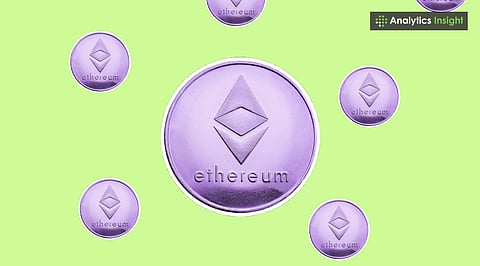

Over $429 million exited ETH funds amid global market volatility and US tariff-induced liquidations.
Launches a $200,000 “Attackathon” with Immunefi to test XRPL Lending Protocol vulnerabilities.
Solana partners with Wavebridge for a Korean stablecoin, and Bhutan migrates its national ID to Ethereum.
The global crypto landscape witnessed a lot of developments on October 14, 2025. Major milestones such as outflows in Ethereum ETFs and big blockchain adoption in Asia. Despite the uncertainty of macroeconomic factors and fears of US tariffs, innovations through DeFi, stablecoins, and national blockchain infrastructure continued across the market.
Ethereum ETFs suffered their biggest capital withdrawal in five weeks, with $428.5 million outflow on October 13. The sell-off followed a period of strong inflows just a week earlier, where ETH products drew $488 million as part of a broader $3.17 billion surge into crypto funds.
BlackRock’s ETHA ETF led the outflow with $310.1 million, while Grayscale’s ETHE and Fidelity’s FETH saw outflows of $21 million and $19.1 million, respectively.
Analysts attributed the sell-off to defensive trading triggered by US President Donald Trump’s 100% tariff announcement on Chinese goods, which sparked a record $19-$30 billion crypto liquidation across markets on Friday.
Despite the sharp outflow, experts like Dean Chen of Bitnunix see this as a short-term “stress response” rather than a fundamental reversal.
Also Read: Ethereum Treasury Stocks Suggest Possible Market Turnaround
Ripple has announced a $200,000 global security challenge dubbed the “Attackathon” in collaboration with Immunefi, inviting ethical hackers to test vulnerabilities in the upcoming XRPL Lending Protocol.
The initiative, running from October 27 to November 29, includes a learning period beginning October 13, aimed at onboarding both professionals and newcomers into Ripple’s ecosystem.
The XRPL Lending Protocol introduces a hybrid model combining off-chain credit checks with on-chain transparency to cater to banks and regulated financial institutions.
Ripple stated that the competition’s focus areas include liquidation logic, interest accrual, vault interactions, and permissioned access controls.
Participants stand to win up to $200,000 if critical flaws are discovered, while smaller valid findings will share a fallback pool of $30,000.
Bitcoin ETFs also saw a sharp correction, recording $326.52 million in net outflows on October 13, according to Sosovalue.
BlackRock’s IBIT ETF was the only fund to attract inflows, adding $60.36 million, bringing its total inflow to $65.32 billion.
Grayscale’s GBTC led withdrawals with $145.39 million in outflows, taking its cumulative losses to $24.35 billion.
The total net asset value of Bitcoin ETFs now stands at $157.18 billion, representing 6.81% of Bitcoin’s overall market capitalization.
Also Read: Bitcoin Price Consolidates at $112,000 as Institutions Accumulate via ETFs
California Governor Gavin Newsom has signed Senate Bill 822 (SB 822) into law, ensuring that unclaimed cryptocurrency assets remain in their original form rather than being automatically liquidated into fiat.
The law amends California’s Unclaimed Property Act, mandating that dormant crypto accounts that are inactive for three years be securely held by licensed custodians until claimed by the rightful owner.
“Thank you, Governor Newsom, for protecting Californians’ right to retain their unclaimed crypto,” said Paul Grewal, Chief Legal Officer at Coinbase.
The law, sponsored by Senator Josh Becker, allows the State Controller’s Office to appoint qualified custodians for storage and mandates that any conversion into cash can only occur 18 to 20 months after reporting if unclaimed.
The Solana Foundation has teamed up with South Korean blockchain firm Wavebridge to develop a compliance-ready KRW-pegged stablecoin designed for institutional use.
The partnership will see the creation of a tokenization engine that manages issuance, verification, and regulatory oversight for the stablecoin. Solana will handle technical infrastructure, while Wavebridge will focus on compliance, investor onboarding, and coordination with financial regulators.
“By building on Solana, we aim to establish an infrastructure that even regulated financial institutions can rely on,” said Jongwook Oh, CEO of Wavebridge.
Bhutan has become the first nation to adopt Ethereum for its national digital identification (NDI) system, migrating from Polygon to improve security and scalability. The system already supports over 200,000 users, enabling digital banking, eKYC verification, and secure online services.
Developed by Druk Holding and Investments in collaboration with Bhutan’s GovTech Agency, the Ethereum-based NDI uses W3C DID/Verifiable Credentials standards and offers legal protection under the NDI Act 2023.
“Switching to Ethereum enhances both security and reliability,” said Jigme Tenzing, Secretary of the GovTech Agency. The migration, endorsed by the Ethereum Foundation, was attended by Vitalik Buterin and is expected to conclude in early 2026.
1. Why did Ethereum ETFs see such large outflows?
The $429 million outflow followed US tariff announcements and large-scale crypto liquidations, prompting defensive investor sentiment.
2. What is Ripple’s $200K “Attackathon”?
It’s a global bug bounty inviting ethical hackers to find vulnerabilities in Ripple’s XRPL Lending Protocol before launch.
3. How did Bitcoin ETFs perform?
Bitcoin ETFs saw $326 million in outflows, though BlackRock’s IBIT recorded a $60 million inflow, maintaining its lead in net deposits.
4. What’s unique about Solana’s KRW stablecoin?
It’s designed for regulated institutions, combining compliance and tokenization features through a partnership with Wavebridge.
5. Why did Bhutan migrate its digital ID system to Ethereum?
Bhutan moved from Polygon to Ethereum for enhanced scalability, decentralization, and security, making it the first nation with an Ethereum-based ID system.
